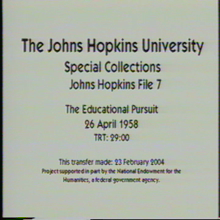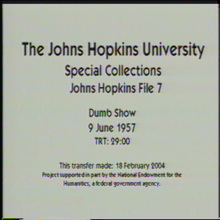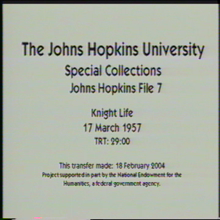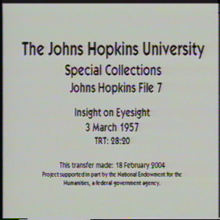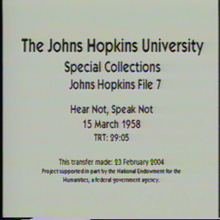
Abstract:
Members of the Johns Hopkins audiology team discuss the interrelationship of hearing language and speech especially in children Dr Bordley explains the hearing process using a mockup of the inner ear and brain Dr Pauls discusses childrens normal speech development and shows children in this learning process Dr Hardy gives examples of how damage to the external or middle ear causes minor hearing problems but damage to the inner ear causes hearing distortion Since the hearing mechanism is an information bearing system children who have problems with loudness pitch or both can have decoding issues However sight taste and smell also contribute to learning so staff and parents can teach a repetitive allsensory form of learning especially for children with aphasia who have language problems unrelated to hearing loss A film shows the observation and evaluation of a child in the clinic to determine whether he has hearing or language problems or a combination of the two Dr Hardy concludes that parents acceptance and guidance is critical in training their hearingimpaired child
Date Published:
1958-03-15

Abstract:
Lynn Poole interviews dancerchoreographer Ted Shawn who maintains that dance is universal Show me the dancing of any people and I will tell you what their king is like is a Chinese proverb claiming that dance reveals the state of a culture Shawn says the motivation for dance is that it brings satisfaction The gamut of human emotions is the basis for dance as evidenced in the Greek theater which was based on dance Dance was originally solo and then social Shawn shows a film of Australian aborigines dancing their stories and film clips of liturgical dance Dance has long been a form of religious expression and ecstasy Shawn shows photos and film clips of some of his dances based on religious themes such as the whirling dervish St Francis and Shiva He discusses turn of the century dance which used very sterile technical styles However Isadora Duncan and Ruth St Denis initiated the renaissance of dance and the forerunner of modern dance Film footage shows St Deniss 1910 Incense and Shawn and St Denis in Tillers of the Soil In 1933 Shawn formed an allmale company that danced American themes shown in photos and film clips Contemporary ballets are influenced by these American pioneer dancers which revealed a vital and vigorous culture
Date Published:
1958-01-25
Abstract:
Lynn Poole interviews five students graduating from the Johns Hopkins University this year He asks premed major Rierson and English literature major Seipt about their future plans how they financed their education what influenced them to attend Hopkins and their comments on the universitys curriculum Allison Furst a Wellesley College graduate is at Hopkins on a scholarship provided by the Fund for the Advancement of Education for a teacher training program She did graduate work in her own field while learning teaching methods and participated in a paid internship Mr Poole asks her about factors in selecting a position after graduation Electrical engineering students Lory and Garbis tell Mr Poole about their interests in this field and about the guidance from and influence of professors William Huggins and Ferdinand Hamburger They also critique the curriculum and describe their future plans
Date Published:
1958-04-26
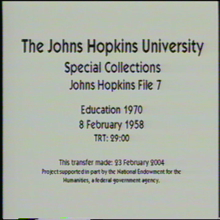
Abstract:
Filmed in his Homewood House office Dr Milton S Eisenhower president of the Johns Hopkins University discusses current quantitative and qualitative problems in education Charts of various aged school populations in 1900 1958 and 1970 show that the number of students in higher education will double by the early 1970s This increase in quantity threatens to reduce the quality of education Public institutions will find it easier to receive funds than will private institutions because endowment incomes have not kept pace with rising costs nor does tuition meet all needs Dr Eisenhower compares the Russian system of education to that of the United States and suggests that our national security is at risk Solutions to U S education problems include increasing teacher salaries building more and better facilities requiring more rigorous training in fundamental courses providing more challenging programs for the more talented students and increasing the tempo at universities for students ably prepared in high school
Date Published:
1958-02-08
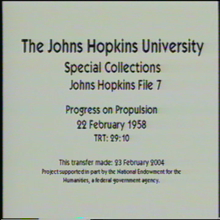
Abstract:
Lynn Poole gives a brief history of aviation propulsion Dr William Avery of Johns Hopkins Universitys Applied Physics Lab describes how techniques of flight have changed from the Chinese rocket of 1232 AD to the ramjet Isaac Newtons equal and opposite principle was the basis for jet propulsion and its first use was in jetassisted takeoffs which allowed shorter runways Dr Avery shows a diagram of a solid fuel rocket consisting of propellant grain nozzle and warhead and contrasts it with a liquid propellant rocket consisting of rocket fuel and oxidizer tanks combustion chamber warhead and valves and pumps He notes that liquid fuel rockets are more subject to failure than solid fuel ones Dr Avery briefly describes the work of rocket pioneers Tsiolkovskiy Goddard and Oberth Further research in the field resulted in the airbreathing engine during World War II pulse jet engine loud and limited in speed turbojet engine by Briton Frank Whittle and ramjet engine first proposed by Rene Lorin in 1910 but requiring supersonic speed Dr Avery describes the key components of the ramjet the diffuser fuel system and combustor He then explains graphs comparing the ramjet and turbojet in four areas of performance and limitations thrust per unit frontal area specific fuel impulse thrust per unit weight and speed and altitude limits proving ramjet the more economical to use In concluding Dr Avery shows how a 1970 airliner with both turbojet and ramjet engines will look and operate
Date Published:
1958-02-22
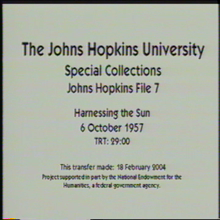
Abstract:
Dr Eisenhower Johns Hopkins University president opens this tenth season of Johns Hopkins television Lynn Poole discusses increasing U S energy needs and predicts that the world may run out of coal in 1000 years and oil in 100 years making solar energy a critical commodity A film clip shows the suns surface and its energy generation is discussed John Yellott executive director for the Association for Applied Solar Energy says that space heating will be the first large use of solar energy He explains the workings of a solarheated house with auxiliary heat pump designed by University of Minnesota architecture student Peter Lee and engineered by Bridgers and Paxton According to Mr Yellot the basic instruments of solar energy are collectors concentrators photoelectricity and photochemistry He shows how solar stills can convert salt water into fresh solar furnaces can be used for metallurgy and other research and solar stoves can be designed for arid countries where fuel is scarce Mr Poole uses a photo flood light to light a cigarette and shows how selenium cells operate a photoelectric exposure meter and 8mm movie camera Mr Yellott demonstrates a radiophonograph developed by Admiral Corp to run on solar cells with backup storage batteries Mr Yellot concludes that at this time large scale uses of solar energy are too expensive but solar is ideal for small amounts of energy in isolated places More research is needed in harnessing this inexhaustible source of power
Date Published:
1957-10-06
Abstract:
This program is about wordless language and is based on the book Nonverbal Communication by Weldon Kees and Jurgen Ruesch Numerous photos and film clips show a series of nonverbal symbols human movement attitudes and emotions social interaction gestures and art forms Famous mime Marcel Marceau performs Youth Maturity and Old Age Also included are film clips from The Little Fugitive and photos from The Family of Man exhibit at the Museum of Modern Art Sam Cobean James Thurber and Charles Stehling provide cartoons Represented photographers include W Eugene Smith Hugh Bell Ruth Orkin Roy Stevens Fred Plaut Gjon Mili and Robert Willoughby
Date Published:
1957-06-09
Abstract:
A dramatization of feudal lords ladies minstrels fools and acrobats in a banquet hall illustrates points about medieval life in this program Dr Sidney Painter professor of history at The Johns Hopkins University discusses chivalry from the French chevalier or knight referring to the ideals of the knightly class He summarizes the events of the Middle Ages and notes that warfare and women were the guiding influences of that period The knights originally barbarous in desires and actions listened to chansons de geste poems of war but they became more civilized as troubadours changed their tunes The Story of Roland for example suggests that knights were to protect the church and punish criminals Courtly poems laid the foundation for preux a term denoting prowess and all the virtues of chivalry Women such as Eleanor of Aquitaine and her daughter Marie further influenced mens behavior by supporting such troubadours as Chretien De Troyes who wrote Erec et Enide
Date Published:
1957-03-17
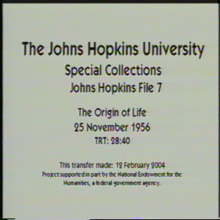
Abstract:
Lynn Poole shows the proceedings of A Chemical Basis of Heredity a symposium of biochemists and geneticists Dr Kenneth Monty a biochemist professor at Johns Hopkins University discusses research on the effect of radiation on chromosomes and Russian A I Oparins theory of the origin of life A chart shows singlecelled organisms such as amoebae and Dr Monty comments on reproduction from a single cell The 1953 UreyMiller experiment attempted to recreate the conditions of the primordial atmosphere with carbon hydrogen oxygen and nitrogen resulting in the precursors of amino acids the main components of living cells Scientist Sidney Fox also discovered that amino acids will organize spontaneously into protein molecules Animated segments show amino acids proteins and nucleotides and how accidents in the original cells resulted in mutation heredity and evolution Nucleic acids are the carriers of heredity and responsible for transformation Dr Franco Rasetti a Johns Hopkins professor of physics who worked with Enrico Fermi in Rome discusses his 10000specimen collection of trilobites or fossilized remains of marine life He shows specimens and photos of various trilobites as old as 500 million years and notes that there is a gap between onecelled organisms and these diversified forms of life from the Cambrian Period He shows a map of Cambrian rock exposures in the U S and briefly explains how to find and remove fossils
Date Published:
1956-11-25
Abstract:
Lynn Poole provides a brief history of the origins and transmission of influenza Dr Charlotte Silverman chief of the Division of Epidemiology and Communicable Diseases Maryland Department of Health describes the production and activities of antibodies and the 1957 vaccination program citing Dr Maurice Hellerman at the Walter Reed Hospital as the person who identified the new type A strain of the Asian flu virus She also explains the international character of the flu which can cause epidemics and pandemics such as the Spanish influenza outbreak of 191819 during which 25 million died A film shows the work of the World Influenza Center in London where flu strains are collected and studied Another film clip illustrates how Asian influenza virus vaccines are made in hens eggs Dr Silverman describes how viewers can protect themselves and lessen spreading the virus Finally Dr Silverman describes symptoms of the flu and offers suggestions for treatment of it
Date Published:
1957-11-02
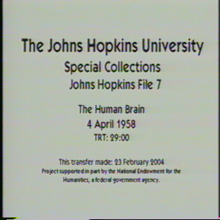
Abstract:
Neurological surgeon Walker explains that the brain is composed of neurons nerve cells that convey impulses to various parts of the body and store memory of impulses He shows a diagram of the dendrites and axons of the neurons and explains a crosssection model of a neuron Lynn Poole lists some of the history of the research on brain functions including that of the early German phrenologist Franz Joseph Gall In 1817 it was demonstrated that electrical stimulus applied to the brain produced movement on the opposite side of the brain giving rise to the existence of motor areas of the brain Using a brain crosssection diagram related to various parts of the body Dr Walker shows how the sensory cortex or homunculus is closely correlated with the motor cortex He also discusses what happens when these areas are injured and how they affect vision hearing and speech The association area of the brain is the temporal lobe Personality and drive may be located in the frontal lobe as lobotomies in that area produce personality change and induce apathy Additional research is needed to discover if patterns of pathways between nerve cells are responsible for psychological differences
Date Published:
1958-04-04
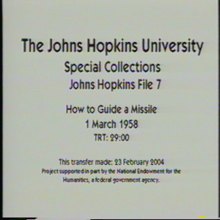
Abstract:
Rear Admiral John Quinn of the US Navys Bureau of Ordinance substitutes for Lynn Poole as host of this program about the Terrier surfacetoair missile developed by the Applied Physics Lab of Johns Hopkins University for the US Navy He asks a member of that Lab Dr Richard Kershner to explain how the missile works and how it was developed Dr Kershner shows a film of the missile in action noting that it doesnt actually hit the target but explodes within close proximity of it On a mockup he identifies the payload or warhead and the solid fuel rocket engine with booster rocket The guidance control system allows beam riding as the onboard computer corrects the missiles course and the missiles antennae pick up the intensity of the radar beams mutations A transmitter on the ground sends a reference signal to the receiver on the missile a signature beam that prevents jamming by other radar beams The electronic information received permits the four hydraulic tail fins to control its flight altitude Dr Kershner also explains a model of one of the terriers control units The first beamrider missile was begun in 1947 and its problems were gradually eliminated as shown in a film shot from a booster section showing flutter Development of such complex missiles requires not only a team of specialists in many fields but also systems engineers or specialty generalists to produce an integrated final product A final film clip from 1952 shows target drones hit by Terrier missiles with warheads
Date Published:
1958-03-01
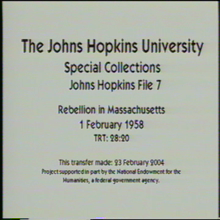
Abstract:
Lynn Poole sets the scene of Shays Rebellion in 1787 Massachusetts and American history professor Charles Barker with the assistance of costumed actors fills in the details This first political protest after the American Revolution was a precursor of Jacksonian democracy and led to the creation of the US Constitution At issue were the farmers caught between mounting debts and insufficient goldbacked paper currency in circulation In numerous towns in western Massachusetts such as Northampton Worcester Great Barrington armed mobs prevented the supreme judicial courts from sitting and sending debtors to prison They were led by Capt Daniel Shays a veteran of the Revolution and farmer from Pelham MA Gen Lincolns army was sent to suppress the insurrections and protect the judicial courts On January 25 1787 Shays rebels attacked the arsenal at Springfield MA but were rebuffed by Gen Shepards troops With the exception of two the rebels were pardoned after asking forgiveness and the government made the reforms they sought Dr Barker recommends two books about the incident George Richard Minots famous History of the Insurrections in Massachusetts and the historical fiction Duke of Stockbridge by Edward Bellamy
Date Published:
1958-02-01
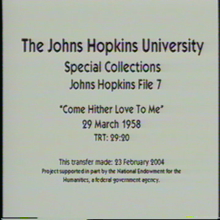
Abstract:
Lynn Poole summarizes the history of the period in which Chaucer wrote The Canterbury Tales Dr Richard Green assistant professor of English at Johns Hopkins University summarizes Chaucers life and the basic plot of the work noting that Chaucer was a civil servant primarily rather than a writer but was a satirical observer of human folly The thirty pilgrims of The Canterbury Tales thus represent all types of human beings Dr Green maintains that Chaucer was an early popularizer of romantic love and ideal marriage and that the moral purpose in Chaucers love stories was that man should love God first and all other things only in so far as they lead him to love of God While costumed actors interpret Dr Green reads passages from the Wife of Baths account of five marriages the Clerks tale of Walter and Grisilde and the Nuns Priests story of Chauntecleer and Pertelote to show that a wifes submission to her husband is symbolic of reason over passion and of mans love of God but a domineering woman turns this upside down and causes reason to be governed by passion
Date Published:
1958-03-29
Abstract:
An animated film details the parts of the eye Lynn Poole compares the operation of an eye to that of a television camera Eye prints reveal retinal detachment glaucoma and diseases of the body such as diabetes A diagram traces the evolution of the eye A history of sightrelated research includes Galileos telescope Sir Isaac Newtons experimentation with prisms Dr Thomas Youngs work with astigmatism and Hermann von Helmholtzs development of the ophthalmoscope to look into the interior of the eye Dr Stewart Wolff ophthalmologist at Johns Hopkins Wilmer Eye Clinic displays an electric ophthalmoscope demonstrates a slit lamp using Lynn Poole as a patient and shows slides of cataracts He also explains the test for tunnel vision with the tangent screen and peripheral field examination the Snellen chart to test eyesight and the tonometer to measure the intraocular pressure of the eye
Date Published:
1957-03-03



